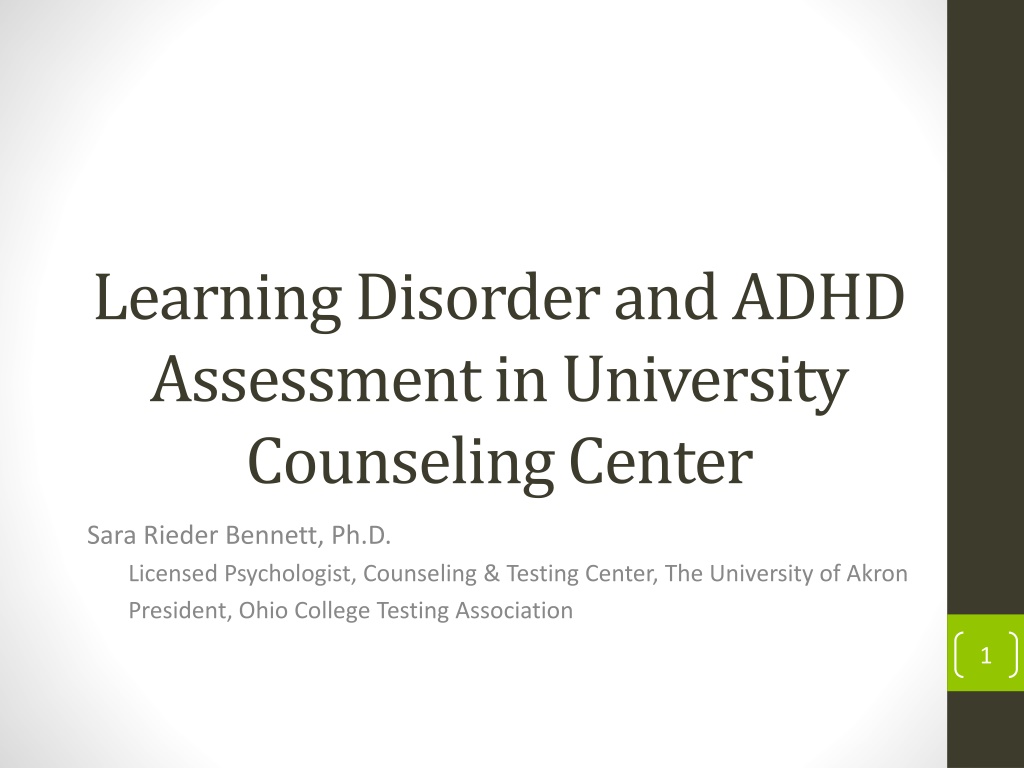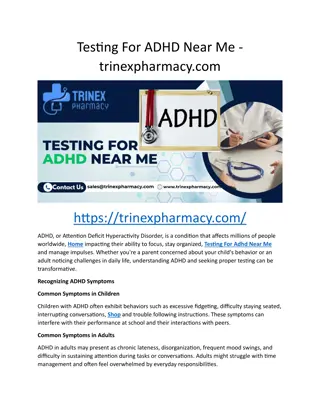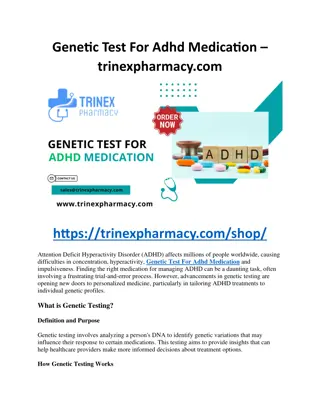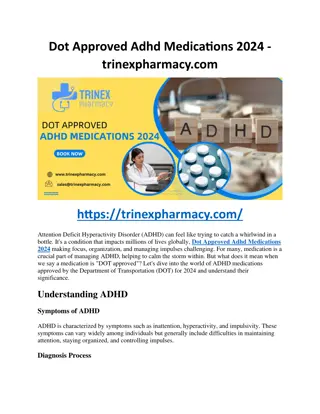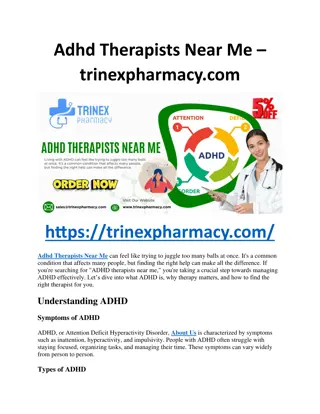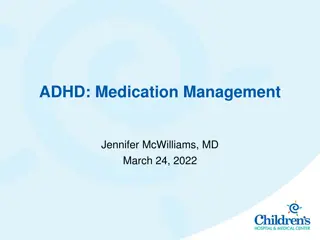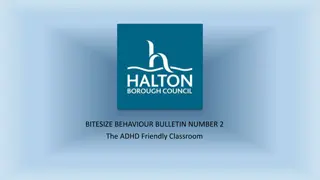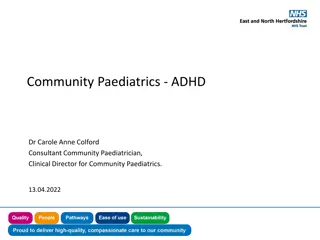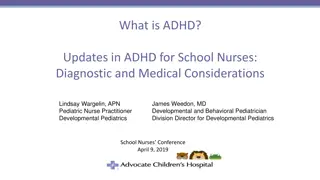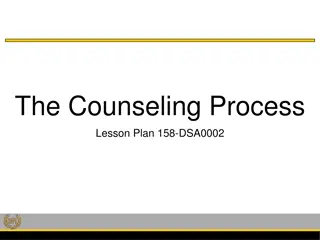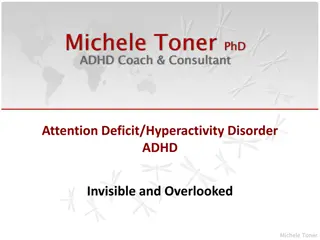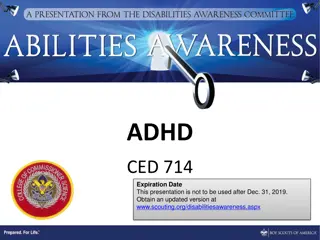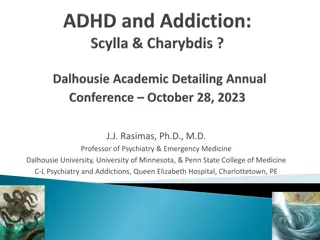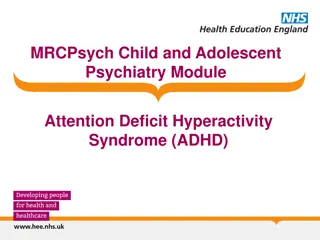Understanding Specific Learning Disorders and ADHD Assessment in University Counseling
This content discusses the diagnosis and assessment of Specific Learning Disorders (SLD) and ADHD in a university counseling center. It covers the symptoms, prevalence, and impact of SLD, focusing on impairments in reading and written expression. The document also highlights the assessment practices, recommendations, and accommodations for students with SLD and ADHD.
- Learning Disorders
- ADHD Assessment
- University Counseling
- Academic Disabilities
- Psychological Assessment
Download Presentation

Please find below an Image/Link to download the presentation.
The content on the website is provided AS IS for your information and personal use only. It may not be sold, licensed, or shared on other websites without obtaining consent from the author. Download presentation by click this link. If you encounter any issues during the download, it is possible that the publisher has removed the file from their server.
E N D
Presentation Transcript
Learning Disorder and ADHD Assessment in University Counseling Center Sara Rieder Bennett, Ph.D. Licensed Psychologist, Counseling & Testing Center, The University of Akron President, Ohio College Testing Association 1
Objectives Provide overview of psychological assessment, diagnosis, and interpretive reports for common academic disabilities Diagnostic categories and associated features Specific Learning Disorders ADHD Practices in psychological assessment Standard batteries at UA CTC Factors affecting test performance Recommendations and accommodations 2
Specific Learning Disorder Diagnoses Difficulties learning and using academic skills, as indicated by the presence of at least one symptom persisting for at least 6 months despite provision of interventions that target those abilities Symptoms include inaccurate or slow and effortful word reading; reading comprehension difficulties; difficulties with spelling; difficulties with written expression; difficulties mastering number sense, number facts, or calculation; difficulties with mathematical reasoning). Identify by specific impairment and mild, moderate, or severe severity. Neurobiological disorder affecting information processing input, processing, storage, expression, output Typically hidden disabilities Prevalence across diagnoses of 5-15%, and adults around 4%. 3
SLD with Impairment in Reading (315.00) 4% prevalence in school aged kids in U.S. Basic skill is below age norm and aptitude decoding, fluency, letter-word recognition, phonemic analysis, comprehension. Processing deficits may include - speech/language delays; auditory processing; phonological awareness; phonemic awareness; phonics; lexical retrieval; ST auditory memory; verbal fluency; visual memory and processing speed Specify if Word Reading Accuracy, Reading Rate or Fluency, Reading Comprehension. Dyslexia refers specifically to problems with accurate or fluent word recognition, poor decoding, or poor spelling abilities.
SLD with Impairment in Written Expression (315.2) Prevalence difficult to identify Basic skill below age norm and aptitude composition, grammar, punctuation, organization, handwriting, spelling Processing deficits dyspraxia; R/L confusion; phonological processing; phoneme-grapheme relationships; lexical retrieval; auditory working memory; visual motor integration, sequencing, memory, processing, and planning Specify if Spelling Accuracy, Grammar and Punctuation Accuracy, Clarity or Organization of Written Expression. May be referred to as Dysgraphia
SLD with Impairment in Math (315.1) 1% of school age children in US Basic skill below age and aptitude recognizing numbers and symbols, understanding math concepts, sequencing not math anxiety, self-efficacy, training Usually present by 5-6th grade due to increased complexity of classes Processing deficits motor skills, VMI, visual-spatial organization, tactile perceptual tasks, attention to visual detail, sequential processing, mental flexibility, LT memory (storage and retrieval) Specify if Number Sense, Memorization of Arithmetic Facts, Accurate or Fluent Calculation, Accurate Math Reasoning. Dyscalculia is alternative term referring to pattern of problems processing numerical information, learning arithmetic facts, and performing accurate or fluent calculations.
Common Characteristics across LDs Developmental Delays Learning to speak Fine motor skills Following directions or routines Coordination Usually family history or developmental trauma like TBI as causal factors Reading Problems Trouble learning ABCs Rhyming words Connecting letters to sounds Errors when reading aloud Frequent pauses when reading Avoid reading aloud or independently
Common Characteristics across LDs Writing Problems Sloppy handwriting Hold pencils awkwardly Persistent spelling errors Letter reversals Confusion of basic words Spell same word differently throughout one piece of writing Other Cognitive Problems Work slowly/impaired processing speed Memory impairments Too little or much attention to details Difficulty with abstract concepts Struggle with summarizing information or answering open ended questions
Common Social Characteristics in LD Misunderstand social rules of conversation, language, facial expressions Frequent pauses/stammering in conversation Trouble understanding jokes, comics, sarcasm Seen as socially awkward or immature Few friends, isolated, and likely experienced bullying or ridicule Seen as liars poor recall of events; intentional hiding of perceived failures Difficulty adjusting to new settings
Common Emotional Characteristics Low self-esteem/efficacy, insecure, thwarted potential Difficulty managing stress and usually under high stress Frustration, feel defeated, angry Anxiety, depression See self as lazy or unmotivated or perfectionistic Family discord
Impact of Learning Disorders Affects access and performance in school, work, daily routines, family life, social context 35% drop out of high school 2x general population 13% attend college within 2 years of HS that of general population rate Fewer attend graduate school or plan to attend 43% at or below poverty level 48% out of workforce or unemployed
Attention-Deficit / Hyperactivity Disorders 3-7% of school age children 50-80% continue to have symptoms in adulthood and most have comorbid conditions Youth with ADHD underreport symptoms, while other college students overreport 50% of variance in objective testing is due to effort and cooperation Assessment is not about the presence of a critical number of symptoms, but their strength: Chronicity Pervasiveness Stability
DSM-5 ADHD A. Persistent pattern of inattention and/or hyperactivity-impulsivity: Inattention Six or more symptoms inconsistent with developmental level, for at least six months, with impairments (Five symptoms if 17 or older) Hyperactivity and Impulsivity Six or more symptoms inconsistent with developmental level, for at least six months, with impairments (Five symptoms if 17 or older) Symptoms were present prior to age 12 Present in two or more settings Interferes with or reduces quality of social, academic, occupational functioning Rule outs 1. 2. B. C. D. E. 314.01 Combined Presentation 314.00 Predominantly Inattentive Presentation 314.01 Predominantly Hyperactive/Impulsive Presentation - In partial remission (less than full criteria for 6 months, still impaired) - Mild, Moderate, Severe 314.01 Other Specific Attention-Deficit/Hyperactivity Disorder 314.01 Unspecified Attention-Deficit/Hyperactivity Disorder
Attention or Executive Functioning Deficit Disorder? Barkley (1993, 94) and just about everyone since then: ADHD is not a deficit in attention, but in the ability to inhibit behavior and delay a response to immediate events. Contingency-shaped sustained attention versus Goal-directed persistence ADHD is multifaceted impairments in executive functioning: Working memory, inhibition, self-monitoring, emotional control, organization, planning, initiating (all subtypes according to metaanalysis in 2004) Processing speed (C, IA; not H/I)
Psych Assessment Models for LD Discrepancy Approach: 1-2 standard deviation discrepancy between achievement and expectations for age, education, and IQ Cutoff Approach: use of normed cutoff scores Ipsative Approach: intra-individual discrepancies (not norm based) Inter-Individual Ability/Cognitive Approach: skills in normative weakness range for general population and confirmed through convergent data sources Across all, attend to rule-outs, exclusionary criteria, and explanatory criteria LD usually impaired WMI and PSI
Integrated Method of Psychological Assessment Observational Data Background Information Research-Based Evidence Quantitative Data an aid to judgment, not a substitute No specific battery exists for LD or ADHD but ethical assessment of either includes investigation of cognitive, language, behavioral, affective, and achievement performance (Gregg, 2009)
Counseling Center Batteries All batteries: Clinical Interview and CCAPS-62, SDS, Review of records, Assessment Screener Questionnaire, WAIS-IV LD: WJ-IV Tests of Achievement, psych measures (e.g. PAI) and collateral interviews as needed ADHD: Student: Barkley Adult ADHD Rating Scale-IV (Current and Childhood), Barkley Functional Impairment Scale, PAI, PRIME-MD Patient Health Questionnaire, Semi-Structured Interview for Adult ADHD Parent/Guardian completes: BAARS-IV (Current and Childhood), BFIS, Interview for Adult ADHD If needed, WJ-IV Tests of Achievement, WMS-IV, Validity Indicator Profile 17
Considerations Intelligence Hereditary Indexes are around .50 Intelligence Scores influenced by: Culture, language, opportunities, interests/curiosity School attendance and quality of schooling Family environment Environmental toxins Motivation, Persistence Anxiety, obsessiveness, ability to tolerate ambiguity Concentration/Attention, distractibility and distractions Sleep, diet, medications etc. Bias of examiner Gender Differences tend to be minimal and specific Race/ethnicity African Americans, Latino(a)s, Native Americans lower than Asian Americans and European Americans (~9 points) 18
Recommendations and/or Accommodations Reports culminate in treatment planning and feedback session with student, with recommendations including meeting with OA to identify accommodations if diagnosis and impairments Accommodations can include Adaptive Study Strategies Program, adaptive technology, alternative media format, classroom, equipment, internship/co-op, recording lectures, note-taker, priority registration, sign language, testing Recommendations: personal, educational, career counseling; academic support services on campus; community resources; online resources (e.g. Pomodoro, Khan Academy); physician referral; speech pathology; rehabilitation, occupational therapy
